Solving These Brain Teasers Will Prove You’re Super Smart
Are you the smartest person you know? Want to prove it? There are thousands of worthy brain teasers on the internet but only a handful that you can solve without printing out the puzzle and using a pencil and a piece of paper to reach the answer. We scoured the internet and uncovered some of the most viral brain teasers that have fooled a lot of very smart people.
We are challenging you to look at each puzzle and solve them before revealing the answer in the next slide. Want to really test yourself? Set a 2-minute time limit for each brain teaser. Share your results with friends and see who has the best problem-solving skills among your group.
The World's Hardest Word Search?
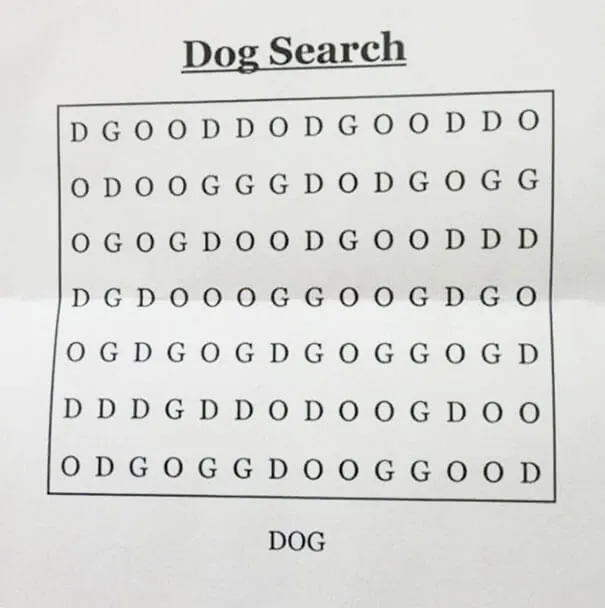
Set your timer and try to solve this puzzle in under two minutes. All you have to do is find the one instance of the word "DOG." In theory, this should be one of the easiest word searches of all time. In reality, many people have claimed to take more than five minutes to find the hidden word. We passed this around our office and a few of our co-workers decided to abandon the search... because they had work to do and this was doing nobody any good.
Dog Word Search Answer

Our brain loves to play tricks on us and this is one of those puzzles that you'll look back on if you missed the word and question your word search skills for the rest of your life. You can perform this same type of puzzle with other repeated letters but the curved shapes of D, O, and G, definitely makes this the more challenging option. This is one of the easier puzzles on our list so prepare yourself for what's head. When you get to the elephant puzzle you'll definitely be questioning how you missed the obvious answer—or you'll be patting yourself on the back.
What Parking Spot Is This Car In?

Math puzzles are some of the hardest to solve. When our teachers told us we would use math in everyday life, we didn't think that would mean all of those times when our friends shared this type of puzzle on their Facebook newsfeed. If you're good with numbers, a problem solver, and enjoy a good joke, this is a fun puzzle to solve. It really shouldn't take you more than 60 seconds so set a timer and get started. If you don't get it. you're not alone because it's a bit tricky. The answer to this mathematical brain teaser is found in the next slide.
Car Puzzle Answer

It's easy to take a puzzle at face value and not think beyond the math or the riddle. In this case, all you have to do is flip the puzzle upside down and you'll quickly realize the view of the puzzle was all wrong. The car is parked in spot 87. Math can be very abstract on its own and it's even worse when there are other outside variables that make the answer harder to find. If you need a break from math puzzles, the next maze-based puzzle will provide you with plenty of fun and frustration without any math required.
The No-Left-Turns-Allowed Maze

This would be the world's easiest maze to solve if there wasn't a single rule holding you back. You are NOT allowed to make any left turns. If you want to challenge your friends, start a timer and see how long this puzzle takes, once you solve the problem, stop your timer and share the results on Facebook. There's a very good chance this puzzle will drive you crazy and you'll just move on to another brain teaser on our list after a few minutes of wrong turns. Once you think you've solved the puzzle, the answer is on the next slide!
Solving The-No-Left-Turns-Allowed Maze

At first glance and after understanding this maze's simple rule, it seems the answer would be simple to find. In reality, there are a lot of right turns needed to solve this maze. Admittedly this puzzle frustrated a lot of our test crowd but most people finished the puzzle after slowing down and really thinking through the process. You really have to be okay with trial and error if you want to brag to your friends about solving this mind-bender. Up next is a math problem that has two very different answers. Can you find both of them or will you get an F- in math puzzle solving?
Tease Your Brain With Some Math

If you have a good understanding of math this puzzle's most obvious answer shouldn't be hard for you to solve. It's basic pattern recognition with an answer that will likely pop out right away and hit you on the head. However, there is a second answer that most people don't arrive at. We are challenging you to take a close look at this mathematical pattern and find both answers. Solve both answers on your own and you are well ahead of the curve. If you can't figure it out the less obvious answer, we have your back on the next slide.
Tease Your Brain With Some Math - The Solution

We've provided the most obvious answer. You arrive at 40 when you realize the answer from each previous question is added to the next section. The first answer is obvious with 4+1=5. Then 2+5+5=12 and 3+6+12=21 before 8+11+21=40.
The second answer is to add the first number to the product of the other two numbers (a + b means a + ab). 1 + 4 means 1 + 1(4) = 5, 2 + 5 means 2 + 2(5) = 12 and 3 + 6 means 3 + 3(6) = 21. That would make the final answer 8 + 11 means 8 + 8(11) = 96. Did you get 96 as your answer? Our next slide is a different type of math teaser.
This Math Triangle Problem Will Play With Your Mind
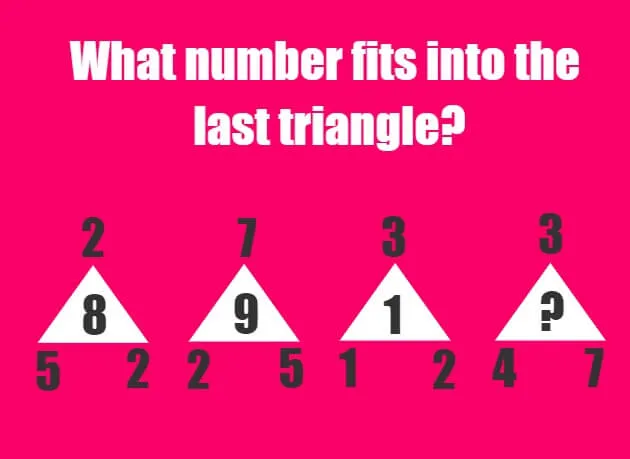
Pattern recognition comes into play for this puzzle but it's all about knowing which pattern matters. Is it a single triangle? A combination of several triangles? You don't need to be a math genius to figure out this brain teaser. Start your timer and see how quickly you can fill in the answer for the fourth triangle. We love these types of brain teasers because they are more about problem-solving, rather than remembering every mathematical equation we were forced to memorize in school. If you get stuck don't worry, we've revealed the answer and how it was achieved on the next slide.
The Math Triangle Solution
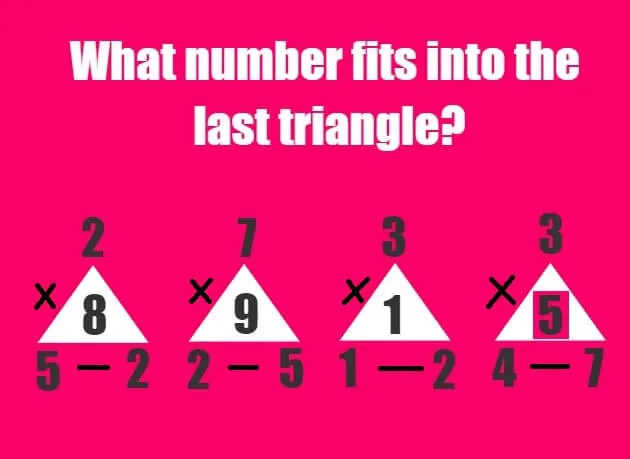
This puzzle is solved by multiplying the top number by the number on the left and then subtracting that answer from the number on the bottom right. This isn't the hardest puzzle on our list but it's a great way to see how quickly you can figure out a mathematical pattern. You can use bigger numbers with this puzzle to make it harder to find the pattern but we thought your brain might need a little bit of a break after the last few brain teasers we threw your way. Wait until you see the elephant brain teaser we have coming your way next.
Can You Spot The Elephant Anomaly?

There are a lot of elephants in this photo but there is also a hidden anomaly hiding in plain sight. Look closely and there is definitely something out of place. We don't want to give anything away because spotting the discrepancy is much harder that way. Set a timer and get to work, if you can find the hidden addition in less than 93 seconds you are better at this type of puzzle than our editorial staff. Once you see the answer you will never forget it. If you can't find what sticks out you can find the answer on the next slide.
The Elephant Puzzle Solution

It's a panda! It's actually kind of a creepy panda but we still love the way they could hide in plain sight. The human brain will see what it believes should be filled in and that can lead to completely missing something that doesn't belong. We fill in letters, numbers, and various other partners that our brain thinks should be in place. Did you find the panda or did you strike out? If pattern recognition is not your thing the next puzzle might be more your speed. Let's shift back to a fun and unique math problem that combines addition, subtraction, and a maze.
Can You Solve The Math Maze Problem?
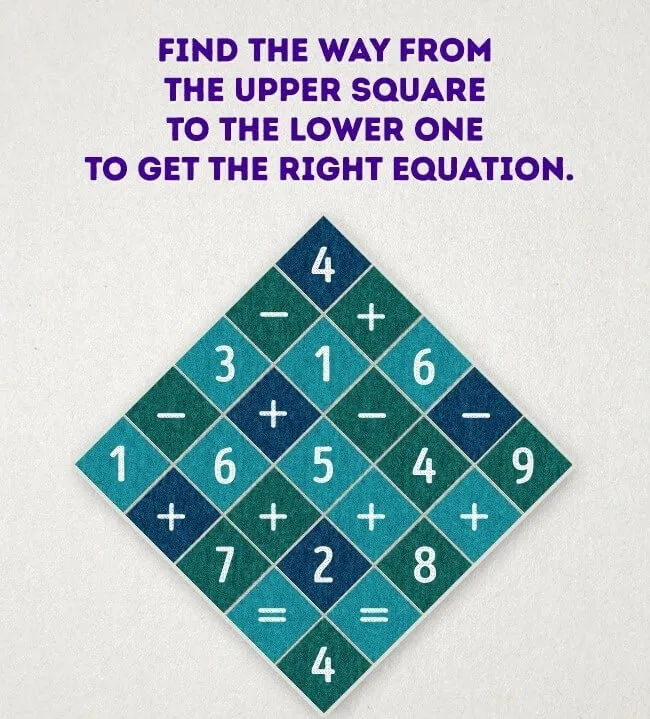
In this brain teaser you get to combine math with pattern selection. Start at the top (4) square and move from one square to the next until you reach the correct answer (4) in the bottom square. You can add or subtract but you only get to use squares that connect from one to another. This problem solver typically involves some trial and error but at least the math problem is simple at its root. If you get stuck attempting a bunch of combinations, you can find the answer in our next slide. Don't forget to start your timer!
Solving The Math Maze Problem

Sorry but we can't provide any type of secret for figuring out these types of patterns. You basically get started, hope for the best, and go until the very end. Admittedly, our editorial team took upwards of five minutes to finish this puzzle. One lucky person we showed the puzzle to figured it out within 20 seconds but that was likely just a lucky guess at the pattern before them since they had no secret to reveal. If you didn't solve this tricky maze you might have better luck with the color puzzle you are about to see in our next slide.
Can You Find The Mistake In This Color Puzzle?

Are you good with numbers? Can you find mistakes that other people miss? Pay close attention to the colored numbers on this slide and see if you can figure out where the mistake was made. Half of our test group solved this puzzle within seconds but a few people couldn't wrap their brain around the numbers and colors presented, leaving them scratching their heads before moving on to the next brain torturing puzzle on our list. Time yourself and see how quickly you find the answer compared to your friends. The answer to this puzzle is located on the next slide.
Can You Find The Mistake? Here's The Solution

It's easy to get into the color or math mindset when you're told to look for a broken pattern or general mistake. Duplicating words often teases the brain, that's why even major news publications with dozens of editors misprint articles with the same word repeated twice from time to time. If you're not looking for a specific type of mistake it's easy to gloss over the most obvious answer that's right in front of you. If you need a math puzzle break after solving this brain teaser we have another "spot the hidden image" slide coming up next.
There's An Intruder Infiltrating The Dark Side - Can You Spot Them?

The dark side might always lose to the Jedi but they are tricky and will stop at nothing to consolidate their power and rule the universe. In this image there is a spy among the stormtroopers and they are once again hiding in plain sight. If you look too hard there's a really good chance you'll completely miss the hidden character. This particular hide and seek puzzle had us scratching our heads for a while but we eventually found the awesome character hidden right in front of our very own eyes. Stuck on the answer? Check out the next slide to find the hidden character.
A Star Trek Solution Courtesy Of A Panda

The adorable panda character strikes again! Seriously, are these animals just masters of hiding in plain site? We can put them next to colored pictures or black and white photos and still they manage to hide with the same type of difficulty. We don't know what good this little character will do against a bunch of stormtroopers, but perhaps they are trained in the ways of the Jedi masters. For our last puzzle you better be ready to look at the letter "b" way more than anyone should. A careful eye and good eyesight are both great for this brain teaser.
The B Search

This was a puzzle that was created with the hopes of proving someone's IQ instead of using a standardized IQ test. The puzzle's author claims that finding all of the letter Bs can show whether or not someone is a genius. It took our team an average of 62 seconds to find all of the letter Bs. We don't know if solving this quickly actually makes you a genius but it's fun to pretend. Set a timer, see if you can find all of the Bs and then head over to the next slide to verify that you are a super genius who can do anything they set their mind to.
The B Search Solution

Did you find the letter "B" four times? Our brains love to play tricks on us and this is no different. The lowercase "b" with the lowercase "d" is a real pain on the eyes and it can easily trick our brains into missing some of the available hidden letters. Share this with your friends on Facebook and see if they can find all of the letter "B" faster than you did.
Here's to hoping you solved all of our brain teasers and don't feel ashamed to brag if you found them easy or finished them faster than you thought was possible.
The Forest of Forgetfulness
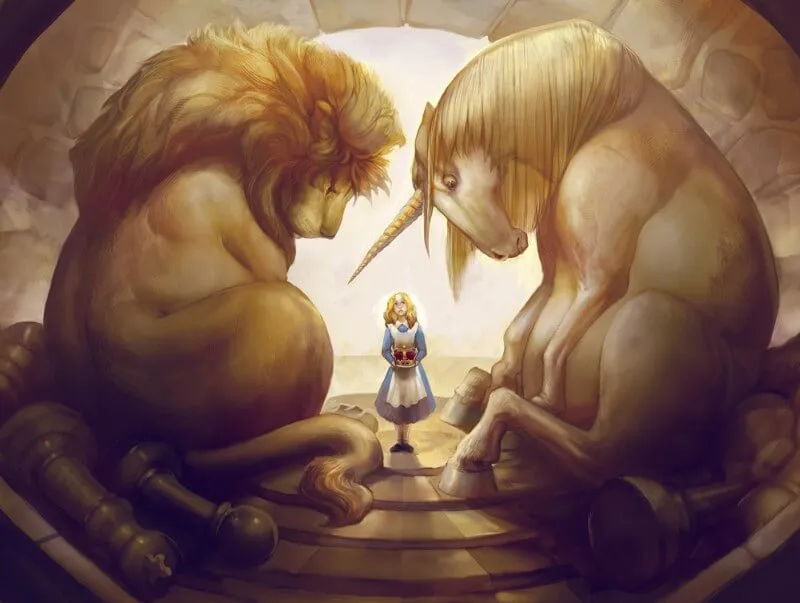
In the forest of forgetfulness lurked many magical creatures. As Alice went upon her journey, it was only a matter of time before she came across several of them. One day she met the lion and the unicorn who were themselves in quite a conundrum. At their feet lay a scroll which read, “The lion speaks the truth all the days of the week except for the days he tells lies which are Monday, Tuesday, and Wednesday. While, the unicorn speaks the truth all the days of the week except the days he tells lies which are Thursdays, Fridays, and Saturdays. The Lion says, “I was lying yesterday.” The unicorn replied, “I was too.” Which day were the two majestic creatures lying? Click over to the next slide to find the answer to this riddle.
The Lion Vs. The Unicorn

Answer: Both the lion and the unicorn speak the truth on one day of the week: Sunday. There is also no one day when both would be lying at the same time, which means one of them would be lying while the other would tell the truth. While if they both said on Sunday that they were lying yesterday that would not work for the lion because that it one of the days it is known that he tells the truth. Therefore, there is only one solution to the problem. The lion and the unicorn both said they were lying on a Thursday about a Wednesday. This means that while making his statement about lying, the lion was telling the truth while the unicorn was lying. Click over to the next slide to try an optical illusion brain puzzle and test just how well your brain can differentiate colors!
The Color Question
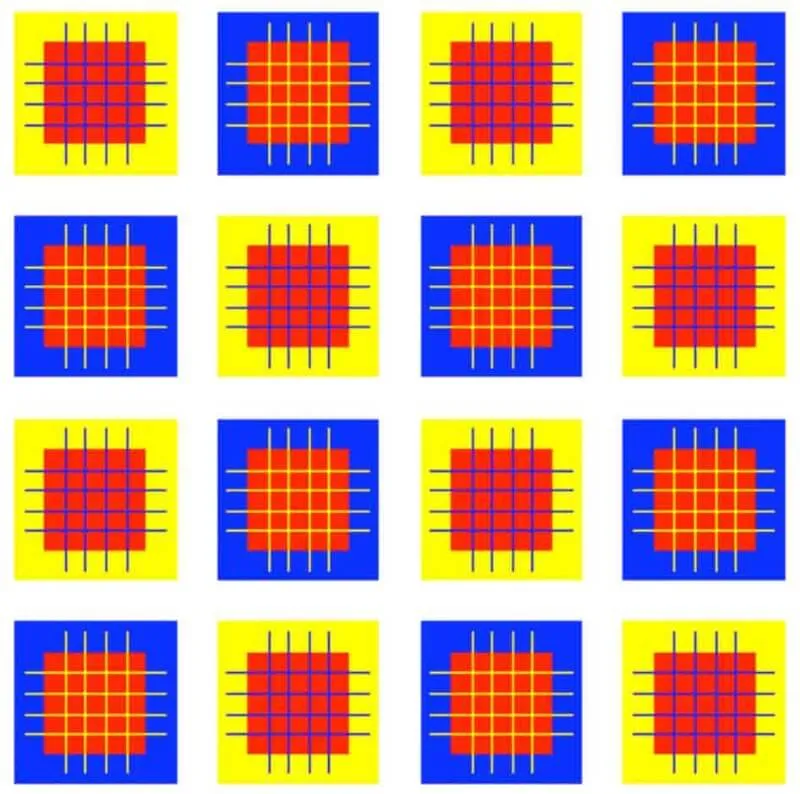
The brain is the epicenter of our bodily function as human beings. Our brain has two hemispheres with four lobes in each section. The occipital lobe is the part of the brain that you will depend on for this optical illusion. That is because the occipital lobe is the part of the brain that controls our vision. In this illusion, you will notice 16 squares. The squares all have a border of either blue or yellow with another color square on the inside. The question is, are all of the squares inside of the blue and yellow squares the same color? Click over to the next slide to find out the answer to this brain teaser!
The Bezold Effect
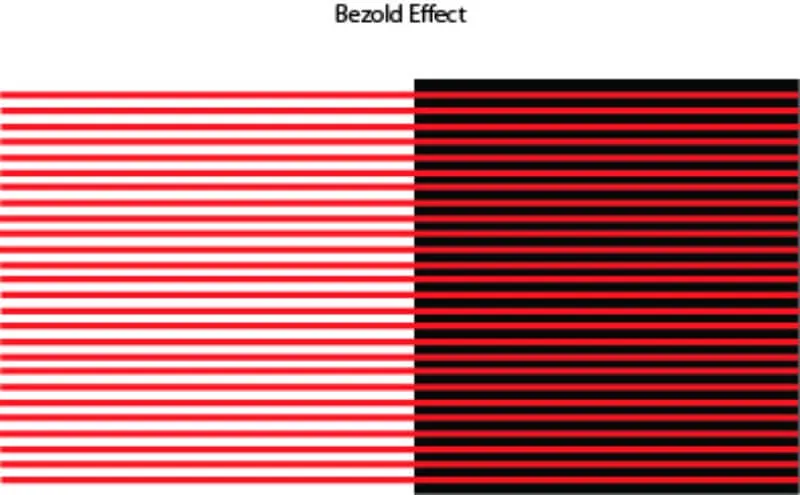
This one is a trick of the eye and the brain. All of the smaller squares inside the blue and yellow squares are the same exact color. The colors only seem to look different, magenta and orange respectively because the brain is perceiving the color differently because it is framed by different adjacent colors. This is referred to as the Bezold effect, which is named after a German professor of meteorology named Wilhelm von Bezold. Bezold discovered that a color might appear different depending on its relation to adjacent colors. Click on over to the next slide to see if you can solve another word puzzle!
The Prisoner’s Conundrum
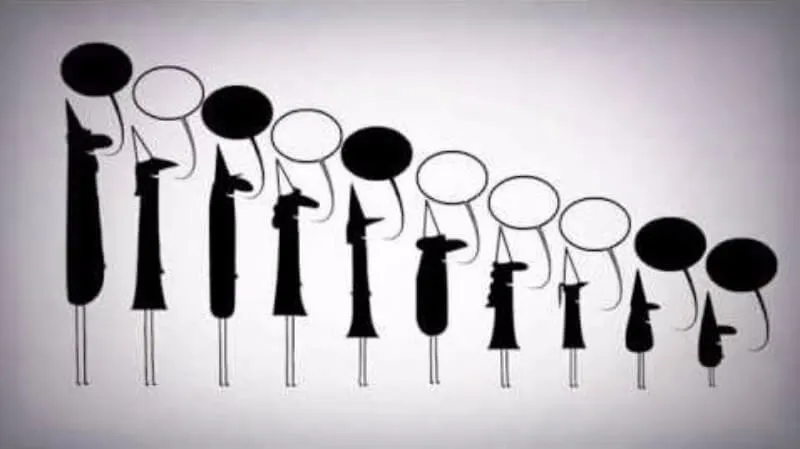
The following is a word puzzle that is also dependent upon putting yourself into the story. You are a prisoner in a jail along with two other men named Barry and Albert. The prison guard puts the three of you in a straight line where you can only face forward. You are the first in line, following by Barry and then Albert. The prison guard has decided to play a little game with his hats. He owns two white hats and three black hats and decides to put one on each of the prisoners' heads at random. No one knows which hat is on their own head. Because Albert is in the back, he can see both your hat and Barry’s. Barry can see yours only. You cannot see anyone’s hat because you are in the front. The guard then announces the rules of the game and says, “First, no one is allowed to say what anyone else’s hats are. If one of you is able to guess your hat color correctly, all three of you will be released to freedom.” Albert goes first, and despite being honest and intelligent, he is unsure. Barry is second, and also intelligent and rational, but also cannot be sure. You are last to answer and you are able to know the color of your hat with 100% certainty. You, Barry and Albert are all released into freedom. Question: How did you know the color of your hat and what color was it?
Freedom Awaits!

Answer: This brain teaser is dependent upon what the two men other than yourself couldn’t see. If Albert had seen two white hats he would have immediately known that his hat was black. This means Albert must have seen either a black and white hat or black and black hat so he had no way to know for sure what he was wearing. Barry was also unsure of what his hat was because the only way he could have known for sure is if he saw a white hat in front of him. You are in front of Barry thus your hat is black. Click to the next slide for a brain recognition puzzle!
The Missing Triangle

This puzzle is to test your brain recognition. Take a deep breath, as the last one was quite a doozy! This puzzle aims to put your frontal lobes to the test by seeing how well your pattern recognition functions. This puzzle also takes a bit of mathematical skill, which is a bit of a hint in and of itself. There are four triangles, and in the middle of each triangle are the numbers 8, 6 and 6. Each number is dependent upon a mathematical equation done with the other numbers on the side of the triangles. The question is what number should be in the last triangle? Give it your best shot and click over to the next slide to find out how you did!
Triangle = Found

Answer: The missing triangle should have the number “3” in the middle. The middle numbers are found by taking the number on top of the triangle and subtracting the bottom left-hand number and then multiplying that by the bottom right-hand number. For instance, we have 6-2 =4x2= 8, the next one is 7-5=2x3=6 and 7-4=3x2=6. Therefore, 6-5=1x3=3. Solved! Now that you know the solution it makes it seem easier than it looks, doesn’t it? With brain teaser such as these, sometimes it’s just as important to slow down and analyze the entire thing before jumping right in. Click over to the next slide for another word puzzle brain teaser!
The Murder Mystery

A murder took place in a family home. The family consisted of a husband, a wife, their son and a daughter. One person out of the family of four is the one who committed the murder. One of the four also witnessed the murder take place. And lastly, the remaining one out of the four aided the murderer in their misdeeds. Here are things that we know: 1) The oldest person and the witness are not the same gender. 2)The youngest person in the family and the victim are not the same gender. 3)The person who helped the murderer and the witness are not the same gender. 4) The person who helped the murderer is older than the victim was. Lastly, here are two constants: 5) The father was the oldest member of the family. 6) The murderer was not the youngest member of the family. The question is who was the murderer? Click over to the next slide to see the answer to this murder mystery!
The Murder or Murderess Reveal

We know from 2) that the youngest person and the victim are not the same gender. We also know from 4) that the person who aided the murderer and the person who witnessed the murder are not the same gender. Lastly, from 6) we know that the murderer was not the youngest. This means the only one that the youngest could have been was the witness. In 5, we are also told that the father is the oldest. And from 1) the oldest and the youngest are not the same gender which means the youngest is the daughter. The only two left are the mother and the son. From 2 we know that the youngest person and the victim are not the same gender. This means that the son was the victim. Therefore, the mother was the murderer! Click over to the next slide to test yourself with another optical illusion brain teaser!
The Black And White Issue

While this one seems to be quite straightforward and the answer seems quite obvious, make sure you really pay attention to what the answer might be. Remember, as mentioned previously, optical illusions like these are often dependent upon how the eye sees and interprets images, which is totally a product of our brain function and more specifically the function of a particular lobe in our brain – the occipital lobe. The premise is simple, just look at the image and answer the following question: Are the horizontal lines seen in the image straight or crooked? Click over to the next slide to find out the answer to this brain-teasing illusion!
The Café Wall Illusion

The horizontal lines are actually straight! This illusion is referred to as a café wall illusion. This illusion actually has its roots in geometry and refers to parallel straight dividing lines between staggered rows with black and white tiles actually appear to be crooked rather than straight. The illusion was first discovered in the late 1800s and referred to as the kindergarten illusion before being “re-discovered” in 1973 by Richard Gregory when a member of his laboratory noticed the illusion on the tile of a café wall, hence the new name. Click over to the next slide for a new word puzzle brain teaser!
The Emperor’s Offer

Imagine the scenario: You are a prisoner who has been sentenced to the worst fate of all – death. However, the Emperor has decided to offer you a chance, a simple game by which you will win your life. The Emperor gives you fifty black marbles and fifty white marbles. He also hands you two empty bowls and then gives you some simple instructions. He says "you must separate these two marbles into the two bowls I have given you. You may divide them any way that you want but you must use all the marbles. When you are done dividing, I will mix the bowls around. You then can choose a bowl and remove one marble. If you choose a white marble, you will live. If you choose a black marble, you will die." How will you arrange the marbles in order to have the best chance of choosing a white one? Click to the next slide to find out how to survive this task!
How To Win Your Life
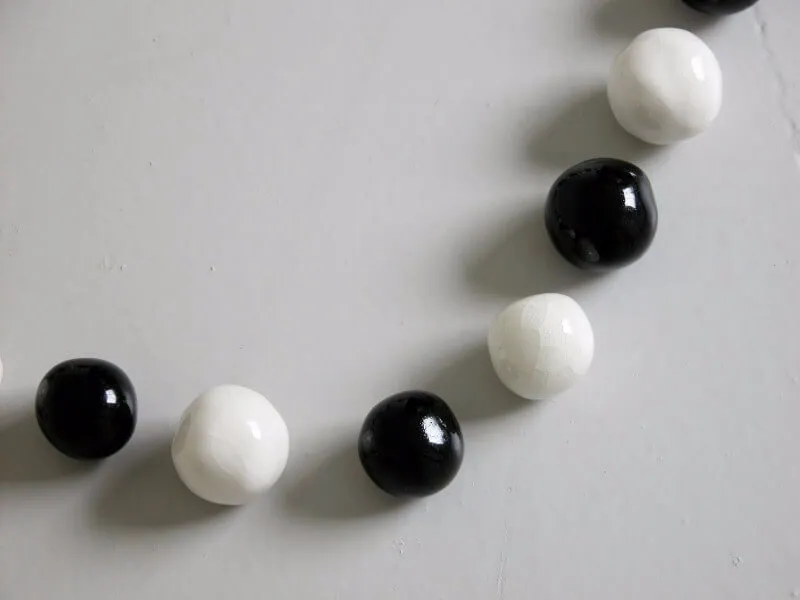
With the fate of your life resting in the hands of marbles, you must do your absolute best to survive. In order to have the best chance, you should place one singular white marble in one bowl. In the other bowl, arrange them so you place fifty black on the bottom of the bowl, with the forty-nine remaining white marbles on the top layer of the bowl. Of course, this would be dependent upon the shape and size of the bowls, but it should give you great odds at winning your life. This also of course, assuming that the emperor would be fair. Click over to the next slide to test yourself with another optical illusion!
The Elephant’s Legs
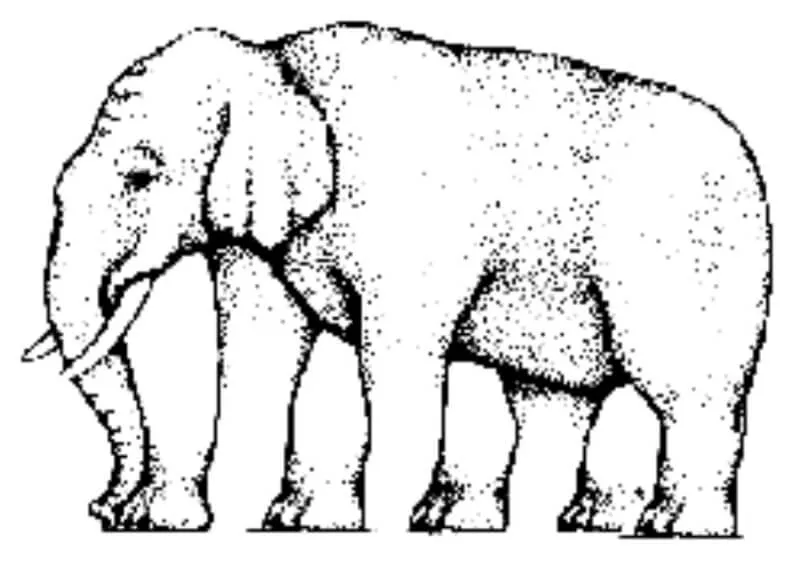
This is yet another optical illusion that directly challenges the occipital orb of our brain. Take another deep breath before really giving this one ago. Remember, exercising your brain is good for you! Also, perhaps reflect on the earlier illusions we have looked at, particularly the fact that we learned sometimes how an object appears is altered by other objects around it. While we know that elephants have four legs in real life, that may or may not be true for this optical illusion drawing. How many legs does this elephant have? Click over to the next slide to find the answer to this optical illusion!
An Illusory Contour
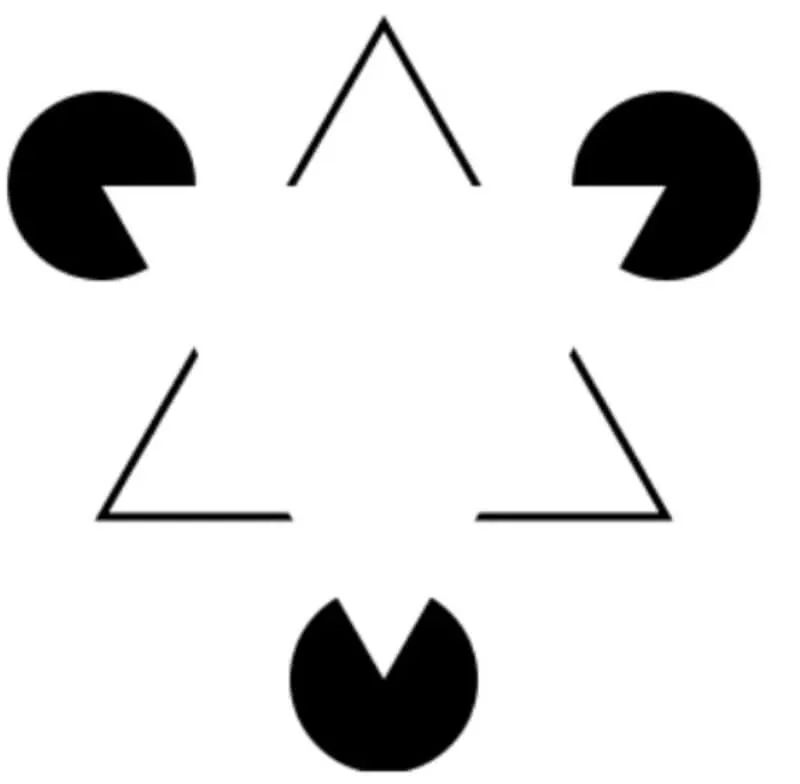
Just like when colors appear to be altered by other colors that appear adjacent to them so, this puzzle is also an illusory contour. There is not a definitive answer to this illusion because the artist actually drew legs but filled in the feet in other openings with the exception of the back leg. It is almost impossible to answer this one definitively even if you squint your eyes. Another example is the above image which is known as a Kanizsa Triangle below. While our brain recognizes a white triangle pointing down, there is not actually an image drawn there. The contour of the triangle has been produced by the shapes adjacent to the figure. Click over to the next slide to try your hand at yet another brain teaser!
The Line-Up
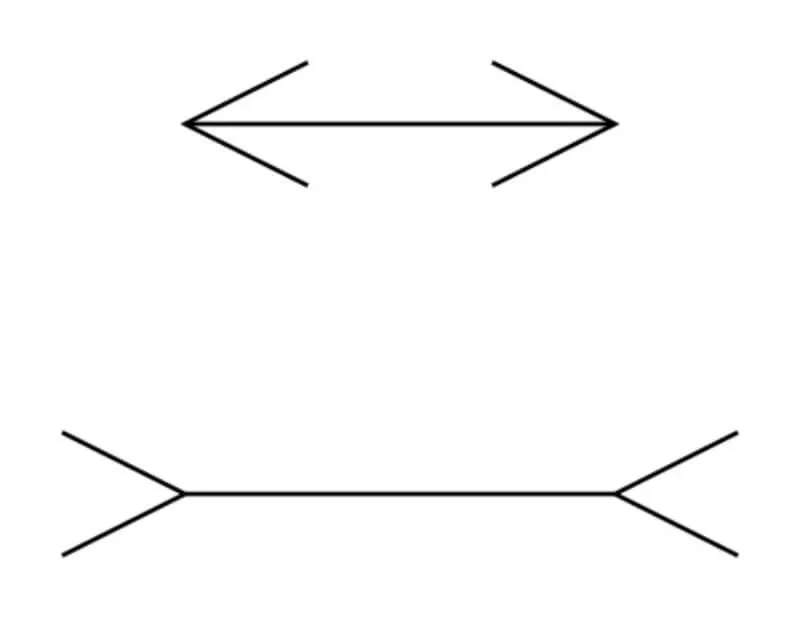
Here is another fun visual game for you. This one is also an illusion brain teaser which means it deals directly with our brain interprets images. Remember sometimes our occipital lobe definitely likes to play tricks on us! Think carefully before you choose your answer for this riddle. The question is: are these two horizontal lines the same length? Or is one longer than the other? While the answer might seem obvious at face value make sure you think it through before deciding on your answer. Click through to find out the answer to this “line-up” brain teaser!
The Muller- Lyer Illusion

This illusion is known as the Muller Lyer Illusion. The two horizontal lines are the same length, although it seems as though the bottom one in the image definitely seems longer. The visual angle gets smaller with distance, because the brain perceives objects at farther distances to be bigger. Farther because some lines have inward flaps like corners of a building they are perceived as being more “closed in” thus shorter, whereas lines with outward flaps seem as though they are longer. This is due to the way our brain perceives angles. Click through to the next slide to try your hand at another difficult brain teaser!
The Blind Beggar

Sometimes riddles can seem as though they are even more difficult of brain teasers than mathematical puzzles. However, if you take a moment to slow down and let all the words really sink into your brain you will figure it out in no time at all. The following is a riddle. A blind beggar had a brother who died. What was the relation of the blind beggar to the brother who died? The answer is not brother. Now, it’s your turn to give this difficult riddle a shot, what’s the answer to this riddle? Click through to the next slide to find out the answer to this blind beggar riddle!
The Deciding Factor

While this riddle seems pretty straightforward it is often really difficult to solve this one. This is almost a social conditioning issue because most readers often immediately make an assumption that they know the gender of the blind beggar. Most people believe that the blind beggar is a man, and thus they cannot figure out the riddle. However, the blind beggar is a woman and she was the sister of her brother who died. This kind of puzzle works the frontal lobe of your brain which deals with analytical functions such as reasoning, hypothesis testing, and implicit assumptions.









